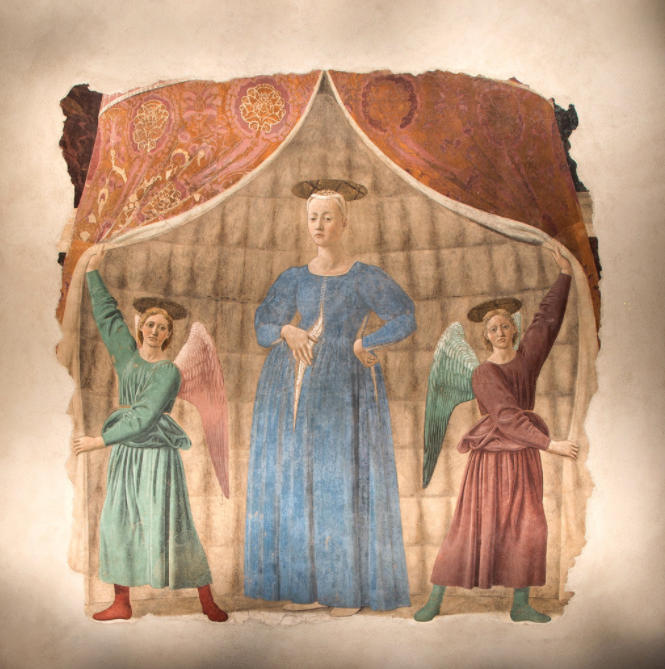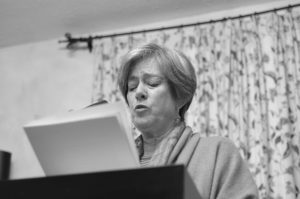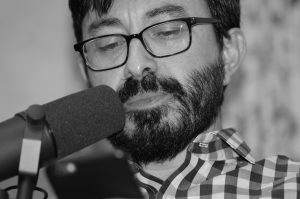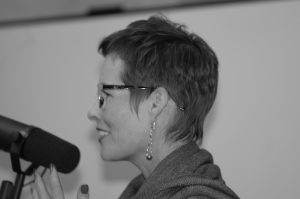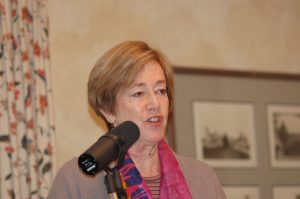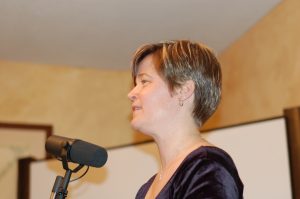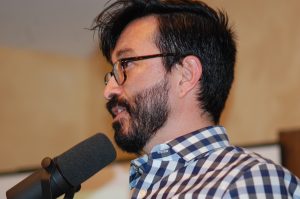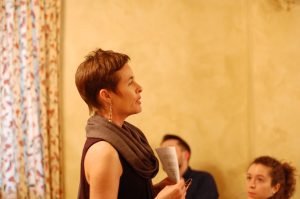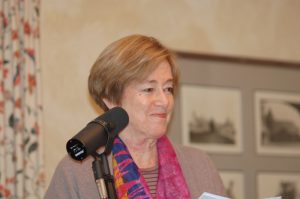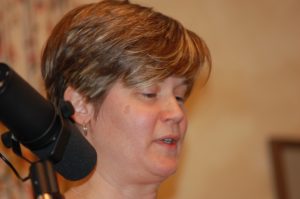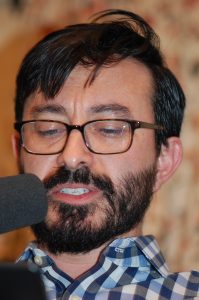Spoon River Poetry Review (SRPR) is pleased to invite you to our seventh annual reading event: The SRPR Lucia Getsi Reading Series, which will take place on Thursday, April 11th, 2019 at the historic Ewing Manor in Bloomington, Illinois. Named for SRPR’s long-time editor and benefactor, Lucia Getsi, the series is co-sponsored by ISU’s Creative Writing Program and ISU’s Department of English. The event features readings by award-winning SRPR poets, followed by a reception with wine and appetizers. This year’s featured poets include the 2018 SRPR Editors’ Prize Winner, Mark Svenvold, Kristin Prevallet, and Jerome Rothenberg. Save the date, spread the word, and bring a friend! Free and open to the public. Donations welcome, but not required. For more information about this event or accommodations, contact SRPR at contact@srpr.org.
Author Archives: Shailen Mishra
The SRPR Lucia Getsi Reading Series 2018
Spoon River Poetry Review (SRPR), published through the Illinois State University Publications Unit, announces its annual reading event. The SRPR Lucia Getsi Reading Series will take place on Thursday, April 19, 2018 (7-10 pm) at the historic Ewing Manor in Bloomington. Named for SRPR’s long-time editor and benefactor, Lucia Getsi, the series is co-sponsored by ISU’s Creative Writing Program and ISU’s Department of English. The event features readings by award-winning SRPR poets, followed by a reception with wine and appetizers. This year’s featured poets include Kelly Michels, the 2017 SRPR Editors’ Prize Winner, Rachel Jamison Webster, and Jamaal May. Save the date, spread the word, and bring a friend! Free and open to the public. Donations welcome, but not required. For more information about this event or accommodations, contact SRPR at contact@srpr.org.
“Come, we can go in”: Contingency and Deep Seeing in Jorie Graham’s “San Sepolcro”
Beth McDermott, Series Contributor
Beth’s series “Ekphrastic Possibility” explores what ekphrasis is, its evolution with the lyric tradition, and the craft of writing ekphrastic poems.
One might consider Homer’s description of Achilles’ shield or Ashbery’s “Self-Portrait in a Convex Mirror” to be touchstone ekphrastic poems because of where they exist in the ekphrastic tradition, creating bookends for a kind of continuum James A. W. Heffernan charts in Museum of Words: The Poetics of Ekphrasis from Homer to Ashbery. For Heffernan, both of these writers’ texts illustrate the impetus to narrate the ostensibly fixed image, with Ashbery’s meditative poem not only narrating, but also commenting on the nature of representation, by turns addressing the painter and the art critic, ushering ekphrasis into the postmodern age. But just less than a decade after Ashbery published “Self-Portrait” in the August, 1974 issue of Poetry, Jorie Graham wrote “San Sepolcro”: a poem Heffernan might have looked at in his 1993 study that is heavy on male poets and also maintains, as part of its theoretical argument, a male/female antagonism between poetry and visual art. While Heffernan is not the first to put “the sister arts” in a contested relationship, his argument that the relationship is binary and gendered perpetuates a limited understanding of sex and gender and ignores the way poets like Graham and Elizabeth Bishop have used ekphrasis to overlap perspectives, rather than create division. Despite these limitations, Heffernan’s definition of ekphrasis as “a verbal representation of a visual representation” (3) is useful for keeping in mind that ekphrasis is characterized by layers of representation, and is often quoted in literature that acknowledges the difficulty of clearly defining an ancient and ever-changing mode.
But maybe there’s more relevance to ekphrasis’ ancient roots than a gendered contest for mastery would allow. The “Theories of Media” glossary at The University of Chicago describes how ekphrasis was taught as an exercise to Greek students of rhetoric: “The student of ekphrasis was encouraged to lend their attention not only to the qualities immediately available in an object, but to make efforts to embody qualities beyond the physical aspects of the work they were observing.” Here I’m especially interested in what it means to “embody qualities beyond the physical aspects of the work,” and whether thinking about a space beyond the work might allow us to see the ekphrastic poem and the visual representation it re-presents as contingent: a partnership that evidences either text’s insufficiency, rather than the potential for one to silence the other. What if the best ekphrasis, informed by its ancient history, gestures beyond the physical work in an effort to broaden or deepen the frame lines that bestow upon the work its perceived autonomy?
Graham’s “San Sepolcro” is a clear example of ekphrasis moving beyond the physical work and allowing the reader to participate in what I will call “deep seeing.” Rather than the poem being another static object alongside or in contest with the two-dimensional painting, Graham’s ekphrasis argues for contingency between poem, painting, and history. The narrative impulse Heffernan claims of ekphrasis is observable in the way Graham expands the spatial and temporal dimensions of the Madonna del Parto, a fresco by Piero della Francesca. But Graham’s narrative impulse is more concise than digressive, and might be better described as a lyric impulse, especially if we keep in mind Helen Vendler’s response to sociopsychological critics in The Art of Shakespeare’s Sonnets. Arguing against “the persistent wish to turn the sequence [of the Sonnets] into a novel (or a drama),” Vendler cautions against forgetting that “the true ‘actors’ in lyric are words, not ‘dramatic persons’” (2-3). The lyric impulse in Graham’s ekphrasis doesn’t narrate the fresco so much as pierces it, drawing the arrow back to a point in history that doesn’t quite exist. If one were to sketch the shape of the deep seeing “San Sepolcro” enacts, it would look like an acute-angle opening onto contingency. The depth that Graham’s lyric impulse achieves through linguistic play that embodies both the structure of the poem and the structure of thinking (Vendler 3) undercuts the iconic, two-dimensional representation of Christ’s impending birth; instead of keeping us at a respectful distance, Graham’s speaker welcomes us to “go in.”
The first poem of Jorie Graham’s second collection, Erosion (1983), “San Sepolcro” begins with an invitation:
In this blue light
I can take you there,
snow having made me
a world of bone
seen through to. This
is my house,
my section of Etruscan
wall, my neighbor’s
lemontrees, and, just below
the lower church,
the airplane factory.
The invitation to go with the speaker is possible due to coldness on loan from snow—a great leveler. The lines “snow having made me / a world of bone” work in two ways: syntactically, the speaker and her world are “bone / seen through to,” which also makes sense on a biological level: the speaker doesn’t exist apart from her surroundings; she exists in a world of bone. Even her “Etruscan” wall (by far one of the most curious words in the poem), suggests that she is not outside of time but of time, part of a pre-Christian culture suppressed by a growing Roman empire. She is a relic, like her section of wall is, and the word “bone” implies.
This contingency between the speaker and her surroundings is further emphasized in the description that ensues:
A rooster
crows all day from mist
outside the walls.
There’s milk on the air,
ice on the oily
lemonskins. How clean
the mind is,
holy grave. It is this girl
by Piero
della Francesca, unbuttoning
her blue dress,
her mantle of weather,
to go into
labor.
In a place like San Sepolcro, with its porousness belying the conqueror’s attempt to erase history, Graham’s omniscient speaker perceives the barely perceptible elements that coat and penetrate the living. She herself partakes in this overlapping: the mind metaphorically transitions to the girl in the painting in a clean lateral sweep reminiscent of a brush sweeping the canvas. The mind is “this girl / by Piero / della Francesca,” as if the speaker doesn’t exist separate from what she perceives. In numerous ekphrastic poems the description is so heavy that we may hunger for a narrator’s presence. But whether there are “dramatic persons” or not, perspectives exist; we come to know them through what Vendler calls “the structure of thinking” mimicked by the poem’s structure and the words themselves (3). In the case of “San Sepolcro,” description of the painting doesn’t occupy that much of the poem. But much like her predecessor William Carlos Williams, Graham’s speaker doesn’t stand back and reflect on her emotional connection to the painting; chilled to the bone, the speaker’s mind presses against the painting, which, like snow, gives way. We are thus permitted to enter into history:
Come, we can go in.
It is before
the birth of god. No one
has risen yet
to the museums, to the assembly
line--bodies
and wings--to the open air
market. This is
what the living do: go in.
It’s a long way.
And the dress keeps opening
from eternity
to privacy, quickening.
Questions of ownership exist in the white space between “eternity” and “privacy”: before god, one is permitted entry; art exists outside of the museum, and money hasn’t yet exchanged hands. But “privacy” is where things resist, however quickly that resistance is overcome:
Inside, at the heart,
is tragedy, the present moment
forever stillborn,
but going in, each breath
is a button
coming undone, something terribly
nimble-fingered
finding all of the stops.
Of course this is an erotic poem, and the painting is, too; the Madonna has her hand at the seam where her dress has begun to open—exactly where Graham’s speaker finds entryway into the painting. But the poem is about the act of “going in,” not the big reveal. Although the last few lines are “meta” in the sense that “stops” is self-referential, “going in” is an endless process that’s bigger than our private lives. It’s the search for truth, not truth itself. The poem teaches, through ekphrasis, deep seeing in the drama of its unfolding, in the speaker, alive as any of us, doing what the living do.
Works Cited:
Graham, Jorie. Erosion. Princeton UP, 1983.
Heffernan, James A. W. Museum of Words: The Poetics of Ekphrasis from Homer to Ashbery. U of Chicago, 1993.
Vendler, Helen. The Art of Shakespeare’s Sonnets. The Belknap Press of Harvard UP, 1997.
≅
Beth McDermott is the author of a chapbook titled How to Leave a Farmhouse (Porkbelly 2015), an associate editor with RHINO, and poetry editor for Kudzu House Quarterly. Her poetry has appeared in journals such as DIAGRAM, Storm Cellar, and Southern Humanities Review, and she regularly reviews for American Book Review. She’s an assistant professor of English at the University of St. Francis and lives in New Lenox, IL.
Lucia Getsi Reading Series – 2017
We are very happy to share with our readers photographs of the of 2017 Lucia Getsi Reading Series hosted on April 6 at the historic Ewing Manor in Bloomington, IL. The invited readers were Nancy Hewitt, the winner of 2016 SRPR EP Contest, Ann Hudson, and Ruben Queseda.
Photo credits: Jasper Zona
- Kirstin Hotelling Zona, Editor, SRPR
- Nancy Hewitt
- Ann Hudson
- Ruben Queseda
- Kirstin Hotelling Zona, Editor, SRPR
- Nancy Hewitt
- Ann Hudson
- Ruben Queseda
- Kirstin Hotelling Zona, Editor, SRPR
- Nancy Hewitt
- Ann Hudson
- Ruben Queseda
To Live in Half-inch Homes: Loss and Nostalgia in Agha Shahid Ali’s Poems
Shailen Mishra, Blog Editor & Series Contributor
Shailen’s series “Space in Culture” explores the motif of space in the works of Indian poets and poetry.
The late Indian (or Indian-American) poet Agha Shahid Ali’s poetry collection The Half-inch Himalayas is divided into four sections. Each section roughly corresponds to a particular aspect of the poet’s life, which in turn maps to a particular geographic location or dislocation. Section one discusses stories of parents, the ancestor who “comes from Kandahar…and claim[s] descent from the holy prophet [Muhammad],” the grandmother, and the hedonist grandfather. At the same time, it is quite likely that most of the poems in this section are imagined in Kashmir, Ali’s home state in India. Section two often has Delhi as its location and perhaps refers to when Ali lived in that city. In section three, the location of the poems shifts to US. These poems speak of an immigrant’s experience. The three sections so far follow the poet’s migratory arc: from Kashmir to Delhi to Pennsylvania. The fourth and the last section of the collection captures most feverishly the torment of homesickness and dislocation that accompanies an immigrant. As far as the geographical setting of this section is concerned it can be best described as a place away from home. In all the four sections, the evocation of a specific location coincides with an intense longing to revisit the lost past.
The very first poem of the collection, which even precedes the four sections, talks of a postcard that arrives from Kashmir and that depicts the Himalayas. Stirred by homesickness, Ali writes: “This is home. And this is the closest / I’ll ever be to home…” Ali was not barred from Kashmir or India. He could have visited there any time if the necessity arose. Yet, his lamentation seems to suggest that the chance of returning home and to its scenery are lost forever. Even if he returns, he writes:
the colors won’t be so brilliant,
the Jhelum’s waters so clean,
so ultramarine. My love
so overexposed.
And my memory, will be a little
out of focus, in it
a giant negative, black
and white, and still undeveloped.
These metaphors of photography err to the side of failing to capture accurately and memorialize the original (read “home”), which is lost forever to an immigrant. To pine for the original and to fail in the attempt to reconstruct it are the theme of Ali’s collection. To talk of the original is also to talk of origin, the source, framed in a particular time and space. When the source disappears or becomes inaccessible, much effort and pain go into recovering it by relying on some sort of mediation. The nature of mediation could be a photograph, dream, memory, or words, but they are ill-fated to fall short. Since approximation and surrogacy can never replace the original, the loss becomes permanent.
In the poem “Dacca Gauzes” from section one, the grandmother rues about the vanished craft of Dacca gauzes and the rarity of such fine fabric:
my grandmother just says
how the muslins of today
seem so coarse and that only
in autumn, should one wake up
at dawn to pray, can one
feel that same texture again.
One morning, she says, the air
was dew-starched: she pulled
it absently through her ring.
Substituting moist air for fabric may seem futile. But it is the close approximation to the original now extinct. Imagination is the mediation the grandmother has to rely on even if it means being pathetically tricked by it.
Change the mode of mediation from imagination to poetry, the result is still the same. The object of longing cannot be reclaimed. In the poem “After Seeing Kozintsev’s King Lear in Delhi,” the narrator mourns over the lost splendor of Delhi’s ancient regal bazaar whose ruins are now appropriated for begging and hawking. The fall reminds the narrator of the last Mughal emperor of Delhi, Bahadur Shah Zafar, who, an accomplished Urdu poet, wrote from the exile about his yearning to return to his capital city:
“Unfortunate Zafar
spent half his life in hope,
the other half waiting.
He begs for two yards of Delhi for burial.”
He was exiled to Burma, buried in Rangoon.
In section three, somewhere in US, vacating an apartment means saying farewell to the time spent there. The separation is renditioned as erasing the material possession and the footprints of memory. When the cleaning crew arrives to clean the apartment and get it ready for the next tenant:
They burn my posters
(Indian and Heaven in flames),
whitewash my voice stains,
make everything new,
clean as Death.
There is no scope of rebirth here. Loss is reduced to just remains or “tombstones.” The last section of the book, the most haunting and dreamy, is devoted to the exile’s homesickness. Often times the narrator is split into two entities. The other half of the narrator that exists outside of him is an ideal entity, who is more religious, a caring neighbor, and a better friend. The ideal entity, an illusion, a phantom of dreams, fixes the slights in the narrator’s duties. It’s as if the narrator assigns his original role (of a close-by son, friend, and neighbor who never leaves home) to this alter ego through the mediation of dream. But then dreams have their own cruel logic, their own punishing endings. The poem “I Dream It Is Afternoon When I Return to Delhi” is a dream within a dream. The narrator dreams of returning to Delhi and following an old routine of taking the city bus to watch a movie with a friend. The tantalizing and slippery nature of dreams threaten to betray the narrator’s “return” until the fantasy finally implodes with the narrator being ejected from the movie hall for holding a “ten years old” ticket. The original dream still does not end though:
Once again my hands are empty.
I am waiting, along, at Purana Qila.
Bus after empty bus is not stopping.
Suddenly, beggar women with children
are everywhere, offering
me money, weeping for me.
To be pitied by beggars and to be offered money by them: how poor you have to be? The poverty here is of rootedness. To have not met an old friend for ten years is sad in itself but what makes it tragic is to be caught in a circuitous trap of trying to relive those memories and failing in the attempt. This wistful undertaking to reproduce the richness of the original is a nagging habit, even more so for an immigrant. The habit cannot be given up despite its painful futility. Ali describes the cruelty of such repetitious behavior this way in the poem “Houses”:
The man who buries his house in the sand
and digs it up again, each evening,
learns to put it together quickly
and just as quickly to take it apart.
How can a house like this be sturdy, lasting, and secure? Or why the necessity even exists to rebuild it each time? And then to take it apart? Ali’s poems are a requiem for things no longer available, separated by time and space. Yet, that does not stop the seekers from trying to reproduce the lost originals through an imperfect medium riddled with inadequacies, artificiality, pastiche, limitations, and absurdity.
≅

Shailen Mishra is a book hopper, story whore, poetry pariah, novelist, three times failed guitar learner, and an aspiring didgeridoo player. He holds a Ph.D. from Illinois State University and an MFA from North Carolina State University. In his spare time, he edits SRPR’s blog and manages its website.
The SRPR Lucia Getsi Reading Series 2017
Announcement: The Spoon River Poetry Review (SRPR), published through the Illinois State University Publications Unit, announces its annual reading event. The SRPR Lucia Getsi Reading Series will take place on Thursday, April 6, 2017 at the historic Ewing Manor in Bloomington. Named for SRPR’s long-time editor and benefactor, Lucia Getsi, the series is co-sponsored by ISU’s Creative Writing Program, and ISU’s Department of English. The event features readings by award-winning SRPR poets, followed by a reception with wine and appetizers. This year’s featured poets include the 2016 SRPR Editors’ Prize Winner, Nancy Hewitt, and several others. Save the date, spread the word, and bring a friend! Free and open to the public. Donations welcome, but not required. For more information about this event or accommodations, contact SRPR at contact@srpr.org.
Here’s the link to the Facebook event page: https://www.facebook.
On Jesse Nissim’s Where They Would Never Be Invited
Jessica Cuello, Guest Contributor
Book Review: Where They Would Never Be Invited by Jesse Nissim
San Francisco, CA: Black Radish Books, 2016. 56 pages. $17.00.
When I was a little girl—and even now—I stared into the windows of houses. Inside other houses was ideal love and emotional fulfillment. Even my dreams were filled with houses where I wandered, searching for my own psyche. Jesse Nissim’s Where They Would Never Be Invited literally peers into one of our most primal needs: the desire for home.
The book is divided into three long poems: All Entrances, Open House, and Nesting Instinct, and in them, Nissim evokes an old idea—that the reason we linger over architecture and objects in the first place is because we project ourselves onto them. The poems exude loneliness, and often a heart-wrenching emptiness, while depicting the most vulnerable parts of people without the presence of people.
In a strange and luminous way, the physical elements of the house overpower the human. The humans remain at a distance, seeking intimacy and safety via a home’s interior: “Late at night I covet the warmest / feeling the tile anticipates. / I want an easy refuge I can touch / I seek freezers fully stocked.”
Yet Nissim reminds the reader that houses fail to protect. The material world is just as ephemeral and even more fragile than our intangible longings. It too can be sold to us and taken from us. It too can offer to fulfill our desires and leave us empty. So too can it fail to protect us from the elements:
A tornado opened a surprise
in the vicinity of nestled children.
No coastline grumbled a response.
A schoolhouse whose nameplates
disappeared when all the windows
lifted up. Signs and critics and
replicas rushed in like water views
skewered on unsuspecting buildings.
Yes, I have heard of the sea. Have you
heard it filling with debris?
Nissim dismantles the brick and mortar of homes and reveals them to be thinly disguised dreams. Whatever we hope to control by living within a home, whatever we hope to preserve, is no safer than anything else. In poem one, “All Entrances,” she writes:
I build the house eternally a mechanical enclosure
with sharply bolted doors. Translucent delusions
Not only does Nissim tear apart the market lie and the promises of advertisers, she reveals that home ownership is part of a larger American mythology. Nissim writes, “I want to suggest a bigger more opulent guilt / about the subject. The dream—no longer / a new-placed “stable” star—now has / beautiful cost-lines and cranky stains.” In emotionally charged images, Nissim shows how “We participate in the human nourishment” and have ingested the images of domesticity and intimacy from the housing market. She writes:
Years boxed for reassembly
to know covetous lineage
brick by brick and the gilded
furniture. Vast near the coast
of cavernous spaces, sometimes
there is a tapestried doorway
covering God’s money.
The poems draw not only on our desires—what we wish houses would do for us—but on the economic realities of the 2008 housing market crash. Nissim states in her acknowledgements that she “started this book amidst the economic recession and the resulting housing crisis of 2008.”
Lines like “The narcissistic wound / humiliated our walls. / We were a bad reputation,” encapsulate how houses conflate our emotional desires with materialism.
Home becomes a physical reminder of human failure: “Throughout my displacement my dreams / have become ordinary. The wish language / of desire is unmet…”
The language underscores the resulting demoralization and fear connected to losing one’s home. If we are homeless are we also nameless? Are we without family? Are we a loser as a father? As a mother? Homes are falsely tied to our identity and value:
Despite wide lawns a house is symptomatically
nameless. Part deserted or debased, a few paces
ahead a glorified symmetry. A father.
His enchantment. His blank step before him.
Part of the beauty in this book is in the depiction of the objects themselves; Nissim captures the spookiness of an object without an owner, and the poems themselves are endowed with the kind of charge that objects deeply associated with humans exude. The poems are both tender and electric. Houses represent an essential desire for safety—for arrival at a place free from fear—and Nissim demonstrates that it is not possible, that this hope has been made impossible. It is a lie that wounds those who believe in it. Nissim looks sympathetically at the human cost of that lie and, in fact, lays a partial groundwork for our current historical moment post-election.
≅

Jessica Cuello is the author of Pricking (Tiger Bark Press, 2016) and Hunt, which was selected as the winner of The 2016 Washington Prize from The Word Works. She is also the author of three chapbooks and a recipient of The New Letters Poetry Prize, a Saltonstall Fellowship, and The Decker Award for outstanding teaching.
Meditations on Poetry, Leaving, and Fleshy, Porous Communities
Emily Ronay Johnston, SRPR Managing Editor
Emily Johnston’s series “Traumatic Emplacement” explores poetics of emplacement, and the simultaneity of dislocation and enmeshment in traumatic poetry.
I have just left Illinois—Spoon River’s homeland, my home of the last six years, a land of stalky grasses shuffling together the demons that have followed me from previous homelands of Massachusetts, Vermont, New York, California, Montana, Alaska, Nevada—for a new job in Delaware. I am already grieving the loss of a place that has nurtured my very best self—one that isn’t really “self” at all, but a humming of connections, of delicious community. The Midwest has allowed me to experience my demons not as disparate embodiments of inevitable torment that amount to an impossible wall of emotional ick, but as a congealed mass of stories that the mind compartmentalizes, for purposes of survival, and that I can, if I choose, rupture.
As the now-congealed mass of narratives that is my mind skitters across all of the tasks and excitements and sadnesses that come along with moving, I return to these lines from Bruce Bond’s essay, “The New in the News: Poetry, Authenticity, and the Historical Imagination,” featured in the current issue of SRPR: “Poems thrive on the new in the old, the old in the new, how each lies embedded in the other in dissonant dialogue” (p. 109).
While Bond is discussing the nature of poetry here, his words also express the dissonance of change, movement, birth, and death that are intrinsic to the human condition. Just as poems “thrive” on blending the new and the old, humans also “thrive” on the endless task of dissolving what no longer serves us and gathering close what does—even (and perhaps, especially) when we cannot fathom the connections between the two. How can we, when change inevitably and consistently arrives, keep our demons from scattering back into their traumatized disconnectedness where they fester and rewound? How can we see the past anew? How can we make the unknown familiar? How can we, indeed, thrive on our embeddedness?
Leaving is a process of returning to what matters, a coming undone, a shapeshift into some new body—a fleshy animal body, an earth body, a body of water, a mass of enmeshed bodies no longer resembling their disparate parts, having, together, become something entirely new. For many writers (and certainly for me), what matters, what moves our work beyond ourselves, is our relationship with “community.” Art, at its core, is a momentary materialization of community.
Case in point: The Word Bombing Reading Series. Curated by a collective of Central Illinois-based writers, past and present—Jordan Cox, Alan Lin, Evan Nave, Xuxa Rodriguez, Eric Longfellow, Brian Hedgepeth, Jeffrey Higgins, Michael Wollitz, and Laurel Perez—Word Bombing enacts the very momentary materialization of community that is art, over and over again (at least once every season). Held in an old homeless shelter-turned-art-gallery now known as ComeTogetherSpace, Word Bombing is a celebration of language, performance, and ultimately, of community. As local writers take the stage to perform 3-5 minute “word bombings”—from poems and short works of fiction and nonfiction, to improvised explorations in sound—Word Bombers “promote positive verbal vibrations” and “send them out” to the Bloomington-Normal, Illinois community and beyond (as founders Evan Nave, Jordan Cox, and Alan Lin explain).
“The general openness to experience and trust of one another” that is Word Bombing’s core philosophy has allowed many writers to experience a profound sense of belonging, says recent Word Bombing Curator, Jeffrey Higgins. For 35 year-old Jeff, Word Bombing was “the first time” he felt part of a community of his own choosing.
Emboldened by this sense of connectedness, Jeff initiated The Illinois House Project, a poetry-based multimedia documentary of sorts that attempts to understand the past and its relation to the material present, to really inspect what has come before (for examples of how this project is currently materializing, see Things Are Tough All Over, published by PRESS 254, and Jeffrey’s current video projects, described on his GoFundMe page). The Illinois House Project is “an archaeology of my own past, whatever that amounts to,” Jeff says.
Yet as The Illinois House Project has unfolded, the inadequacy of “personal experience” becomes glaringly obvious. “I am only one gnome/node/note (you pick) in a whole field of gnomes/nodes/notes,” Jeff says. In allowing for experimentation, ComeTogetherSpace has given many like me, like Jeffrey, permission to delve into our pasts, to not quite know what we’re doing as we’re doing it, and to do it anyway.
How can I leave Word Bombing behind? Central Illinois? The so many people I have loved and still love there? How can I, by leaving, return to what matters? I can’t participate regularly anymore in the Word Bombing experience of coming together in random chairs (everything from your average metal folding chair, to cozy velvet antique chairs and old wooden church pews), in a wide open space with a faux wall-fan at the front and a spacious wooden stage—itself, an enactment of community, of art. I cannot use the bathrooms reminiscent of elementary school, peruse the upstairs gallery space, or graze at the table of hodgepodge snacks (whatever Word Bombing’s minimal budget allows).
Regular visits. Phone calls. Skype sessions. Donating to Jeffrey’s current filmmaking project on Route 66, part of the larger Illinois House Project. Donating to ComeTogetherSpace via GoFundMe to help keep their doors open, after the City of Bloomington required them to install an expensive new sprinkler system. Money is communal.
Practice, cultivate what Illinois has offered me: the desire, the wherewithal, to rupture those thoughts and feelings that have long-provided an illusion of separateness. We all leave, only to come together again in some new, unforeseen way. We are all, constantly, arriving.
≅
 Emily is from Boston, San Francisco, Fairbanks, Alaska, and Central Illinois. Holding a Ph.D. in English Studies and an M.F.A. in Creative Writing/Poetry, her work emerges at the intersections of writing studies, social justice pedagogy, trauma theory, film theory, and narrativity. In particular, she researches and publishes on students’ literacy learning in relation to issues of sexualized trauma. She has taught courses in academic writing, public writing, creative writing, gender studies, literature and film, and English as a Second Language. Emily is a Postdoctoral Researcher in Writing Pedagogy at The University of Delaware, and Managing Editor of Spoon River Poetry Review (SRPR).
Emily is from Boston, San Francisco, Fairbanks, Alaska, and Central Illinois. Holding a Ph.D. in English Studies and an M.F.A. in Creative Writing/Poetry, her work emerges at the intersections of writing studies, social justice pedagogy, trauma theory, film theory, and narrativity. In particular, she researches and publishes on students’ literacy learning in relation to issues of sexualized trauma. She has taught courses in academic writing, public writing, creative writing, gender studies, literature and film, and English as a Second Language. Emily is a Postdoctoral Researcher in Writing Pedagogy at The University of Delaware, and Managing Editor of Spoon River Poetry Review (SRPR).
The Appositional Project: Travis Macdonald’s “Concrete Jungle” and the Ethical Possibilities of Conceptual Poetry
Ryan Clark, Series Contributor
Ryan Clark’s series “The Appositional Project” examines poetry that makes use of appropriative writing methods (such as cut-up, erasure, and homophonic translation) to investigate intersections of place and domination/loss.
Over the last few years, there have been many who have protested against the self-declared “a-ethical” work of Conceptual poets like Kenneth Goldsmith, who in particular seems to relish stirring up controversy with his belief that no text is too sacred to manipulate for the purpose of creating art. Such poets tend to claim that poetry should not be held to any moral standard, that poets should focus solely on creating art rather than become bogged down by concerns over ethics. Without giving this perspective too much credence, however, I want to focus on a work of highly conceptual poetry which does not hesitate to engage questions of morality, and whose author displays consideration for how readers might be moved to be more mindful of their interaction with the various ecosystems they encounter.
Travis Macdonald’s “Concrete Jungle” is a series of concrete poems which take the shape of various American states, creating a sort of map in which instead of one of the standard colors shading bordered areas (pink, orange, light green, etc.) the land mass is filled in with the names of invasive plant species currently found in the state. Rather than standing as an a-ethical art piece encouraging us to think about the meanings and connections behind the poem and its composition, “Concrete Jungle” asks us to think as moral beings about how ecologies of place have become dangerously disrupted. These poems not only push for us to recognize, but to be considerate of our interactions with our ecological surroundings. This alternate mapping asks us to consider our relationship with the environment, particularly relating to the concept of borders and how we move through them.
Speaking about his project in a September 13, 2013 issue of the online literary magazine The Clearing, Macdonald writes:
As a nation of immigrants whose collective identity (our very American-ness) has often defined itself in opposition to a shifting other (most recently those of Hispanic heritage) we Americans tend to be inordinately preoccupied with ideas of border and origin. The fact of the matter is, these plant species did not arrive here by accident. They were brought here, in many cases very deliberately, by our colonist/immigrant ancestors. We label them invasive in order to establish their otherness, their opposition to our idea of a “pure” or “natural” ecosystem. And yet, by doing so, we also seem to be disavowing our own agency in the process, our own invasive nature. We seem to say: “Look, we are working hard to keep these evil invaders in check.” In this way we conveniently gloss over the fact that we ourselves are the invaders responsible for their presence in the first place.
Here is where “Concrete Jungle” highlights the ethical strength of Conceptual Poetry: such work pushes us to think about the world around us and to consider how we might adopt more ethical and responsible ways of being. In this case, we are confronted with a mapping of the ecological threat of invasive plant species, often brought to new ecosystems through human carelessness. Further, this project questions the ideas at work behind native/invasive, man-made borders, and our nation’s status as one founded by immigrants. How many generations must pass before human immigrants become native? How many generations of Russian knapweed? If Ohwi kudzu spreads freely across demarcated lines on a map, then what is a border?
This is a work that is highly conscious of and dependent upon borders. The white space is empty: NOT-Texas, NOT-Iowa; as if there is no possibility of extension, no crossing of lines. We lift this state (or county, or nation) out of the earth as a separate entity from the land that it holds (and that is held away from it). And yet what invasive species so frequently remind us is that lines on a map fail to contain the life which moves as it will (or as we bring it) across continuous stretches of land. Macdonald’s arrangement of the names of invasive species into neatly bordered regions reminds us that only in language can we seek to establish limits on the natural world.
When we replace topography with language (though topographical markings or shading on a map is another kind of language) we encounter space differently. The names of these invasive plant species reflect human interaction, human stories. The example of “itch-grass” in Texas connects the plant to bodily sensation, for instance, while Iowa’s “Queen Anne’s Lace” reflects the flowering plant’s immigration from Europe and particularly the role of the British monarchy in the colonization of what was to become the United States. The idea that a map displays geographic location also becomes disrupted. As it turns out, I have lived in (or will soon have lived in) each state represented in the excerpt from “Concrete Jungle” that was published in The Clearing. If we approximate locations in these poetic mappings, I have lived (in chronological order) in Brazilian peppertree, bindweed, spotted knapweed, Leafy Spurge, and velvetleaf. My grandmother is buried in bull thistle, while my grandfather lives in orange hawkweed.
“Concrete Jungle” is a selective mapping, but then again so is the mapping of human settlements, highways, and even national parks. To what are we paying attention? Here, our attention is being asked of us. Consider our invasiveness, and our complicity with invasiveness. See the arbitrariness with which we choose what or whom is native or invasive. This is a deeply moral question, one which constantly determines how much we are willing to damage our various ecosystems and communities. Particularly when so much language surrounding us has lately become saturated with messages of divisiveness, it is also deeply important.
≅
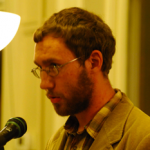 Ryan Clark has dedicated years of his life to homophonic translation and is particularly interested in the reparative potential of appropriative writing, including how poetry responds to violence and subjugation, symbolic and otherwise. His poetry has appeared in Smoking Glue Gun, Tenderloin, Seven Corners, and Fact-Simile, and he also has an essay about teaching homophonic translation forthcoming from Something on Paper. He currently teaches composition at Savannah State University.
Ryan Clark has dedicated years of his life to homophonic translation and is particularly interested in the reparative potential of appropriative writing, including how poetry responds to violence and subjugation, symbolic and otherwise. His poetry has appeared in Smoking Glue Gun, Tenderloin, Seven Corners, and Fact-Simile, and he also has an essay about teaching homophonic translation forthcoming from Something on Paper. He currently teaches composition at Savannah State University.
Reminder of SRPR’s Annual Lucia Getsi Reading
Thursday, April 21st 7-9 PM
Ewing Manor, Bloomington
SRPR announces the fourth annual reading event in the Lucia Getsi Reading Series, which will take place on Thursday, April 21st, 7-10 PM, at the historic Ewing Manor in Bloomington. This event features readings by SRPR poets, and is followed by a reception with FREE wine and appetizers! The series is named for SRPR’s long-time editor and benefactor, Lucia Getsi, and is co-sponsored by WGLT’s Poetry Radio, ISU’s Creative Writing Program, and ISU’s Department of English. For more information about the event or accommodations, contact SRPR at contact@srpr.org or editors@srpr.org. FREE & OPEN TO THE PUBLIC! Donations are welcome, but not required. Spread the word, and bring a friend! Featured poets include Joanne Diaz, Roger Reeves, and the 2015 Editors’ Prize Winner, Julie Marie Wade.

